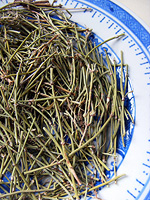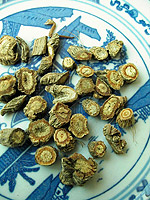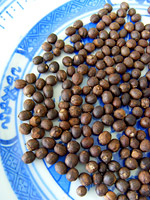Treating Headaches with Chinese Medicine
Exogenous headache types
| Wind-cold | Wind-heat | Wind-dampness |
Endogenous headache types
Liver yang | Kidney deficiency | Qi deficiency| Blood deficiency | Turbid phlegm | Blood stasis |
It should be noticed that the above are just the basic types of headaches in TCM. Headaches can be triggered by so many factors, and individual conditions change over time. The disharmony patterns are changeable and may transform into each other, it is not uncommon to have two or more patterns at a time. For example, when external pathogens induce a wind-cold headache, it may further turn into a wind-heat headache at the end, and there may coexist with the two headaches during the transforming process. Moreover, if the wind-cold or wind-heat condition persists over a long period of time, qi and blood will be impaired, leading to deficiency of qi and blood, or blood stasis, or dysfunctional organs. An experienced doctor can grasp the trend of disease development, recognize the main symptoms from the complicated manifestations, determine the disharmony pattern and give proper treatment. After starting a treatment plan, you should keep track of the results and how it is working. Follow-up regularly, so that your physician can monitor the progress and make changes in the treatment plan as needed.
For various headaches, TCM holistic approach emphasizes on eliminating the pathogens, regulating qi and blood, and restoring organ functions. The treatment strategy for exogenous headaches is often aimed to expel pathogenic factors such as wind, coldness, dampness and heat, as well as restore the flow of the collaterals. The treatment strategy for endogenous headaches is to restore the functions of the organs, qi and blood, therapeutic methods like tonifying the kidney, replenishing qi, nourishing blood, resolving phlegm, and expelling stasis are usually adopted, depending on individual conditions. Generally, herbal prescriptions along with other therapies such as massage, acupuncture and moxibustion are most effective in relieving headaches.
Since the order and arrangement of the meridian flow contribute to the locations of headache pain, they should be taken into account when differentiating disharmony patterns and selecting prescriptions. Messenger or guide herbs play an important role in the prescriptions.
|
Locations of pain |
Associated meridians/organs |
Recommended guide herbs |
|
Back of the head and upper neck (also called tai-yang headache) |
Rhizoma seu Radix Notopterygii Radix Ledebouriellae Fructus Viticis Herba Ephedrae |
|
|
Front head (also called yang-ming headache) |
Radix Puerariae Radix Angelicae Dauhuicae |
|
|
Side of the head (also called shao-yang headache) |
Radix Bupleuri Rhizoma Ligustici Chuanxiong Radix Scutellariae |
|
|
Crown of the head (also call jue-yin headache) |
Fructus Evodiae Rhizoma Ligustici |
|
|
All over the head |
Rhizoma seu Radix Notopterygii Radix Ledebouriellae |
In addition, when headaches accompanied by particular symptoms, certain herbs are indicated.
|
Associated meridians/organs |
Recommended guide herbs |
|
|
Headache with a heavy sensation, and accompanied by diarrhea and sweating (tai-yin headache) |
Rhizoma Atractylodis Rhizoma Pinelliae |
|
|
Headache accompanied by toothache and sore throat (shao-yin headache) |
Herba Asari |
In TCM experience, exogenous headaches are easy to treat and usually have favorable outcomes, while endogenous headaches, that usually are long-term and recurrent in natures, are difficult to treat. Nevertheless, as long as being patient and determined to find the right treatment with physicians, endogenous headaches can also be controlled or even cured.
 Ephedra Ephedra |
 Ledebouriella root Ledebouriella root |
 Vitex fruits Vitex fruits |


